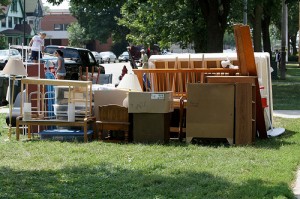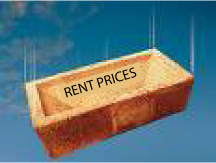Posted by Teresa on April 27, 2009 under Landlord Paperwork and Forms, Landlord Tips | 

Photo Courtesy of flickr
Our last post covered a few tips for making tenant move-out day a little less stress-inducing. Today we’ll cover a couple other helpful procedures you may not be following, and we’ll talk about the elusive definition of “ordinary wear and tear.”
If your experience with the tenant has been positive, maintain a good relationship by offering to provide your soon-to-be-former tenant with a letter of reference. A good recommendation is very helpful, whether they are moving to another rental or buying a home, and your tenant will probably appreciate the offer. They may even do an extra-good cleanup job on your property—and they’ll be sure to tell their friends and family about it. Good publicity is always good to have.
The Move-Out Inspection
It’s best to schedule the final walk-through after the unit is completely vacant, and the tenants have turned in their keys. Then, there is no possibility of additional damage after the official inspection is completed. The tenant should be present. Make sure you work off of the original Check-In Sheet with the tenant’s signature. Compare each item on the checklist with its condition upon move in day. The tenant may claim to have no knowledge of how damage occurred (or that there even was damage); the fact remains that they are responsible.
Once the inspection is completed, inform the tenant that you will have an estimate for the damages in a timely manner. Most tenants are anxious to get their security deposit back; if you indicate the full deposit is in jeopardy, they might offer to do some more cleaning or repair damages. Remember that you are under no obligation to allow this. However, if you know the tenant’s ability and feel they are capable of completing repairs, you may opt to give them a second chance. Keep in mind that a sloppy paint job or improper repair work will cost you more in the long run!
Defining “Ordinary Wear and Tear”
You are entitled to charge tenants for damages beyond ordinary wear and tear. It’s your job to know the difference between “wear and tear” and serious damage that can be deducted from a tenant’s security deposit.
The standard definition of “ordinary wear and tear” in most states is deterioration or damage to the property expected to occur with normal usage. There are no concrete rules, however, so it’s a tricky judgment call in most cases. Here are some examples:
- Smudges on walls and switch plates: Ordinary wear and tear
- Crayon marks on walls: Damage
- A few small tack or nail holes: Ordinary wear and tear
- Numerous nail holes requiring patching and painting: Damage
- Carpet worn thin from use: Ordinary wear and tear
- Carpet stains or bleach spots: Damage
- Dusty or dirty blinds: Ordinary wear and tear
- Bent or missing blinds: Damage
Making Deductions from Security Deposit
First, make sure that your paperwork is accurate, detailed, and thorough. An incomplete list of charges is asking for trouble. Your tenant could decide to challenge the deductions or even instigate court action. Explain how damage is beyond ordinary wear and tear. For example, just listing “Pet Damage, $50” is not adequate. You must provide details, such as cleaning or replacement receipts. Be thorough and avoid the hassle of fighting it out with your tenants. Here are a few guidelines to follow:
- Name each specific item damaged on a separate line.
- Indicate the exact location of the item.
- Detail the damage, including type and extent. Use specific language like minor scratch, excessive staining, five burn holes.
- Detail the repair completed or that the item required replacing.
- Include repair estimates or replacement receipts for each item.
All tenants move out, but following established procedures and keeping communication open can make it a much easier experience for you and your tenants!
For more landlord resources, including everything you need to know about
tenant screening, turn to
E-Renter.com. You’ll know that you have the best possible tenants when you
prescreen tenants.
Posted by Teresa on April 22, 2009 under Landlord Paperwork and Forms, Landlord Tips, Rents and Deposits | 

Photo Courtesy of flickr
Tenants move out. That’s a reality that every landlord and property manager faces. And when working with all types of tenants, it follows that you’ll have all kinds of move-out experiences—some good, some very bad. Here are a few things to look out for, and some procedures you might find helpful.
Preparing for Move-Out Day
You should really have started preparing for move-out day when your tenant moved in. If you were proactively communicating with your tenant from the start, you already completed a Check-In Sheet. Establishing the condition of the unit upon signing the lease, then using the same list to evaluate on move-out day, is a simple way to track any damage and appropriate charges.
Be Consistent
Maintaining clear communication and working from established procedures are two themes we visit often in this blog. If you have standard procedures and forms in place, every interaction with your tenants will be easier on both parties—and will keep you covered from a legal standpoint as well. Remember that you do not want to be seen as discriminating against any tenants, so you must require the same paperwork and notices from all.
Security Deposit Disputes
This is the number one problem in landlord tenant relationships. Many tenants have a fear of not receiving their security deposit back. If you’ve been inspecting the property on a regular basis, then your tenant has had ample opportunity to point out any problems that could affect their deposit. Still, your definition of “ordinary wear and tear” could vary greatly from your tenants’. Be fair, but firm, take reasonable deductions and provide a thorough accounting of the security deposit. Return the balance promptly, and comply with all local laws covering interest and time limits.
Written Notice
If your tenant mentions in passing or calls specifically to inform you they’re moving, let them know you require written notice. Remind them that the rental agreement states this clearly, and that you need to be sure all are in compliance with the lease and with the law. Provide them with a simple Tenant’s Notice to Vacate Rental Unit form, covering the property address, names, dates, reason for moving, and allowing you access to the unit to inspect and show the unit to prospective tenants or repair people. Do not allow the tenant to skip giving you notice in writing—it brings too many possibilities for problems!
Next post: In Tenants Moving Out, Part II, we’ll explore some additional suggested procedures, the Move-Out Inspection, and help define “ordinary wear and tear.”
Posted by Teresa on April 16, 2009 under General, Housing Trends | 

The apartment vacancy rate for the top 79 US markets reached an average 7.2% in the first quarter of 2009, according to Reis Inc., a New York research firm. This is a full percentage point increase from the previous two quarters. Reis predicts rents down as much as 2% for the year, and apartment vacancy rates above 8%.
Increased perks, like lower or free rents, have not helped the situation. In the past, these concessions by property managers led to lower vacancies—but not now. Part of the problem is an oversupply, as unsold condominiums are converted to rental properties. Plus, continued rising unemployment, coupled with the downturn in housing markets, are not bringing former homeowners back as renters. Many are renting their homes, and are now property managers themselves.
Where are all these foreclosed homeowners living? Good question. It’s possible there are more folks living with family or friends. In addition, cash-strapped homeowners are renting rooms to boarders. Packing existing housing with more bodies seems to be the nationwide trend.
In LA County, 41,000 people moved out of an apartment in 2008, while only 29,000 moved in during the last five years. But not all areas are being affected equally. Well-run properties in real estate markets where people want to live are holding steady, while areas of overbuilding are hurting.
Other areas with big increases in vacancy rates in Q1 2009 include Austin, TX, from 7.5% to 9.2%; Fairfield County, CT, from 4.3% to 6%, and Knoxville, TN, from 5.3% to 7%. [Source: the Wall Street Journal.]
It looks like for the remainder of 2009, renters will find more choices within their budgets, while many landlords will be forced to continue cutting rents in an effort to attract new tenants or keep the ones they have. Well-positioned rental property investors could take advantage of unprecedented buying opportunities in certain markets.
For more landlord resources, including everything you need to know about
tenant screening, turn to
E-Renter.com. You’ll know that you have the best possible tenants when you
prescreen.
Posted by Teresa on April 9, 2009 under Landlord Paperwork and Forms | 
 Keeping files in perfect shape is an elusive goal for most of us. But for landlords and property managers, a reliable record-keeping system is a must. If your strengths lie in areas other than document tracking, you may want to consider a property management company, rather than managing income property yourself.
Keeping files in perfect shape is an elusive goal for most of us. But for landlords and property managers, a reliable record-keeping system is a must. If your strengths lie in areas other than document tracking, you may want to consider a property management company, rather than managing income property yourself.
Rental property owners who manage things themselves will benefit from strong record keeping skills. Start with a basic filing system, with separate sections for each rental property you own. Your local office supply store will be full of options, from simple accordion folders, boxes, and plastic tubs, to locking filing cabinets. When you outgrow your simple system, it’s a good idea to invest in fireproof, locking cabinets.
All property ownership documents, such as purchase offers and contracts, appraisals, loan documents, and insurance policies, should be accessible and protected. Store these items separately from the rental paperwork for the property. Keep accurate records of any incidents or claims against your insurance coverage.
Track income and expenses manually, or on spreadsheets. Or consider one of the many financial management or property management software packages available. Software varies in price range and features; check out a few to see which works best for you; or ask around to see what other landlords are using. Reports, correspondence templates, income and expense tracking, and other features may make a software package a good investment for you. But even if you track all your expenses electronically, paper receipts are still required for tax purposes. Keep them in expense folders for each property.
You’ll also want folders for all rental and tenant documentation. These include maintenance records, tenant applications, rental agreements, legal notices, and tenant correspondence. You never know when you’ll need proof of notices, complaints, or maintenance. If you are involved in a court dispute with a tenant, your good record keeping will definitely pay off. You don’t want to be in a situation where it’s your word against your tenant’s!
Rental property records should be maintained for three to five years, depending on the state where you live and/or own property. Property purchase and capital improvement records should be kept for as long as you own the property. Any records pertaining to injuries, evictions, or other legal matters should be maintained indefinitely.
Setting up and maintaining an efficient record-keeping system will pay off again and again. If you find yourself in court with a tenant or in an IRS audit, you’ll be grateful that your records are well organized!
For more landlord resources, including everything you need to know about
tenant screening, turn to
E-Renter.com. You’ll know that you have the best possible tenants when you
prescreen.
Posted by Teresa on March 31, 2009 under Housing Trends, Landlord Tips, Tenant Credit Checks | 

Falling Prices no Cause for Panic
The heated rental market of the past few years is definitely over. Rent increases followed housing price increases to unsustainable levels. Reports from around the country show that rents continue to fall.
In New York City, the biggest drop, 8% over last year, was in the category of studio apartments in doorman buildings. In a city like New York, where rents are excessively high when compared to the rest of the country, that’s significant. Renters in NYC are used to numbers like $3,395 for one-bedroom apartments with a doorman (but you can lose the doorman and pay only $2,632). It’s a tough, competitive market—but people are finding more rental deals than ever right now.
Renters who signed leases at the height of the bubble are more interested in investigating their alternatives—including moving—than before. Most folks are not willing to pay more, but they are looking for—and finding—similar properties for less money.
Other renters are downgrading to cheaper properties just to save money. With job security at a new low for many working people, the opportunity to save several hundred dollars a month only makes sense. Thrift is in, and the ability to sock away money in savings appeals to people who never considered it before.
What could this mean to landlords and property managers? Expect to work a little harder to secure and keep good tenants. It’s a renter’s market, but there are still good, solid tenants looking for rental properties. Make sure your property is in top condition and advertise it well.
In this market, current tenants might ask for rent reductions at lease renewal time. To avoid reducing the rent, think creatively of other ways to keep them. Perhaps you can pay for certain utilities, or upgrade the cable package. If you have a vacancy elsewhere, upgrade a good tenant to a nicer property. A fresh coat of paint or new carpet could be perks a tenant would stay for.
Some landlords, desperate to keep properties filled, are accepting tenants with bad credit. This “I’ll take anyone” approach is a mistake. Tenants with bad credit could cost you much more money over time than you’ll lose by waiting for a solid tenant. And in this economy, a low credit score is likely to get worse, not better. There is no better time to thoroughly check your prospective tenants’ backgrounds and credit histories.
The rental market will swing back up again. Rents are often tied to jobs, and when job numbers increase again, look for signs that rents are on the increase. Until then, be patient, don’t panic, and plan carefully. Consider new ways to keep your properties leased; be open minded to new ideas and to all requests from your tenants. But remember, you are under no obligation to let tenants out of a binding lease, just because they can rent somewhere else for less.
For more landlord resources, including everything you need to know about
tenant screening, turn to
E-Renter.com. You’ll know that you have the best possible tenants when you
prescreen.





